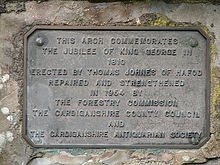Early history
After the dissolution of the monasteries by king Henry VIII (1536–1540) during the English Reformation the abbey's holdings were divided and awarded to new tenants. Some of the Strata Florida lands were granted to the Herbert family, who came to Ceredigion during the reign of Elizabeth I. Sir Richard Herbert of Pengelly and Cwmystwyth was High Sheriff of Cardigan from 22 November 1542.
A rent roll dated 1540 for the granges of Mevenith, Cwmystwyth and Hafodwen (‘newe leases’) reveals that W[illia]m Herbert and Morgan Herbert were tenants of several properties formerly belonging to the Abbey of Strata Florida, including significantly: Havodychdryd Doleygors Pantycrave Bwlch Gwalter parcell of Ty Loge [...] 4 parte of Pwll Piran parte of Pregnant(sic) Prignant Isaf and Blaenmerin and Alltgron. Havodychdryd or Hafod Uchtryd is the name of the house and demesne and the other properties. [3]
The estate became famous in the late 18th century when its owner, Thomas Johnes (1748-1816), developed it as a showpiece of the Picturesque idea of landscape; the estate and the Gothic house were the subject of many descriptions and images produced by contemporary visitors. The history of the estate is the subject of several books, most notably Peacocks in Paradise by Elisabeth Inglis-Jones, [4] and the Hafod Landscape by Jennifer Macve. [5]
Johnes' Mansion
A new mansion at Hafod was built in 1785 by Johnes, after the demolition of the Herbert structure, from the designs of Thomas Baldwin of Bath in the Gothic style. The library was a spacious, octagonal building within the mansion. Johnes collected many rare and noble books on natural history and manuscripts in Welsh, French and Latin, which also included many by Edward Lhuyd and many manuscripts and printed editions of the French chronicles of the later Middle Ages. The library collection of the Marquis de Pesaro was purchased and housed at the estate. [6] A sculpture by Thomas Banks, representing Thetis dipping Achilles in the river Styx stood in the library; The sculpture was commissioned by his cousin-wife Jane Johnes; the head of Achilles is that of their baby daughter, Mariamne Johnes (who lived 1784-1811). This work is currently on display at the Victoria and Albert Museum. [7] Adjoining the library was the conservatory 160 feet (49 m) in length that was filled with a wide variety of rare plants. [8]
Near the entrance from this room into the dining-room hung a painting by Peter Paul Rubens of Decius Mus receiving the Benediction of the Pontifex Maximus . Over the mantel-piece hung a painting of The prophet Elijah fed by the ravens, originally housed at the abbey of Talley, Carmarthenhire, and was, on the dissolution of that establishment, given by the superior to an ancestor of Johnes. Among numerous pictures on display within the mansion were, a portrait of Mr Johnes of Llanvair, by Sir Godfrey Kneller; of Robert Liston, by Wickstead; of Richard Gorges, of Eye, Herefordshire; and of Viganoni; a copy of Guido's Cupid Sleeping, landscapes by Both and Berghem, a painting of the ruined Alchymist by Salvator Rosa. In the drawing-room were, Hogarth's celebrated picture of Southwark Fair , a Descent from the Cross by Van Dyck, an Ecce Homo by Moralez, two landscapes by Claude, a Procession of the Doge of Venice by Canaletti; an Assumption by Bernardo Lonino, pupil of Leonardo da Vinci, which was originally an altar-piece at Lugano; a Holy Family by Rubens, a portrait of Lord Chancellor Thurlow by Gardener, and some beautiful miniatures by Mariamne Johnes. The hall was constructed of Mona marble [9] embellished with a Grecian statue of Dionysus; in addition, six paintings of subjects from Froissart, in imitation of basso relievo, by Stothard.
On 13 March 1807, a fire broke out that completely destroyed the mansion including the contents of the library. Johnes was in London attending Parliament when he heard the news and that his wife and daughter had escaped. [8] The family moved to a rented house in Castle Hill near Aberystwyth. Baldwin of Bath was again hired as architect. On 1 September of the same year, on Johnes's birthday, construction to rebuild the mansion began. Contractors had agreed to pay a heavy financial penalty if the mansion house was not roofed-in by Christmas. Expectant upon moving in Johnes set about replacing the contents of the home. Many of the furnishings were purchased from the Palladian mansion known as Fonthill Splendens, owned by William Thomas Beckford. Interior French glass doors and a number of chimney mantle pieces were purchased, one of which had been sculpted by Banks that featured two couples: Pan and Iris, Penelope and Odysseus. These items were stored at Hafod until the mansion was complete. During construction the family left Castle Hill making tours of London and Scotland, each year returning to find the house unfinished. Construction delays continued until Johnes remained in Wales and made weekly visits, personally overseeing the progress. Altogether the project took three years to complete.
Today
Today the Hafod estate occupies some 200 hectares of the Ystwyth valley and surrounding hills. Most is owned by Natural Resources Wales which, in partnership with the Hafod Trust, [14] is managing conservation and restoration projects with public and private funding. In 1998, the Hafod Estate received a grant of £330,000 from the Heritage Lottery Fund. A detailed management plan has been prepared and is now being implemented. The estate is designated Grade I on the Cadw/ICOMOS Register of Parks and Gardens of Special Historic Interest in Wales. [15]
The Estate employs one full-time and two part-time management and administrative staff, a horse logger, [16] and various contract workers, and has recently appointed two crafts-people. Their roles are to ensure that the management plan is carried out to the highest standards.
Visitors today can follow many a waymarked walk that captures the ‘Spirit of Place’ which is Hafod. The Estate is popular with tourists who wish to enjoy some of the most picturesque views and pleasant walks in Wales. The walks have names such as ‘The Gentleman’s Walk’, ‘The Bedford Monument Walk’ and ‘The Alpine Bridge Walk.’ The grassy parkland areas around the ruins of the old house are homes to diverse populations of grassland fungi, notably waxcaps, are represent one of the best areas in the UK for these fungi. [17]
The church is the splendid focal point at Hafod.
Hawthorn Cottage and pond
Rubble of the house ruins and remaining wall, with fountain
River Ystwyth in spate at Hafod
Fountain mask
Cascade Walk
Waterfall, gentlemans walk
Wish bone bridge, gentlemans walk
Upper part of the Peiryan cascade
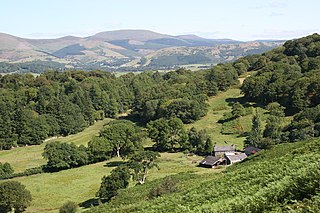
Ceredigion ( ), historically Cardiganshire, is a county in the west of Wales. It borders Gwynedd across the Dyfi estuary to the north, Powys to the east, Carmarthenshire and Pembrokeshire to the south, and the Irish Sea to the west. Aberystwyth is the largest settlement and, together with Aberaeron, is an administrative centre of Ceredigion County Council.

Devil's Bridge is a village and community in Ceredigion, Wales. Above the River Mynach on the edge of the village is a series of three stacked bridges, constructed hundreds of years apart, from which the village gets its English name.
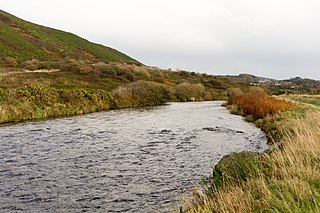
The River Ystwyth is a river in Ceredigion, Wales. The length of the main river is 20.5 miles (33.0 km). Its catchment area covers 75 square miles (190 km2). Its source is a number of streams that include the Afon Diliw, located on the west slopes of Plynlimon on the border of Ceredigion and Powys in the Cambrian Mountains. The Ystwyth flows westwards before its confluence with the Afon Rheidol and the estuary at Aberystwyth to drain into Cardigan Bay.
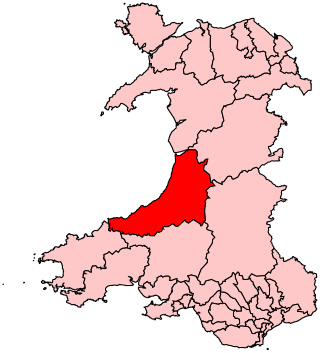
Ceredigion was a parliamentary constituency represented in the House of Commons of the UK Parliament. Created in 1536, the franchise expanded in the late 19th century and on the enfranchisement of women. Its boundaries remained virtually unchanged until 1983. From 1536 until 1885 the area had two seats : a county constituency (Cardiganshire) comprising the rural areas, the other the borough constituency known as the Cardigan District of Boroughs comprising a few separate towns; in 1885 the latter was abolished, its towns and electors incorporated into the former, reduced to one MP. The towns which comprised the Boroughs varied slightly over this long period, but primarily consisted of Cardigan, Aberystwyth, Lampeter and Adpar, the latter now a suburb of Newcastle Emlyn across the Teifi, in Carmarthenshire.
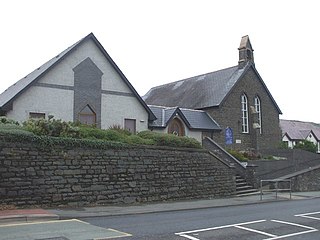
Penparcau is a village and electoral ward in Ceredigion, Wales, situated to the south of Aberystwyth.

Croft Castle is a country house in the village of Croft, Herefordshire, England. Owned by the Croft family since 1085, the castle and estate passed out of their hands in the 18th century, before being repurchased by the family in 1923. In 1957 it was bequeathed to the National Trust. The castle is a Grade I listed building, and the estate is separately listed as Grade II*. The adjacent Church of St Michael is listed Grade I.

Llanfihangel y Creuddyn is an ancient parish in the upper division of the hundred of Ilar, Ceredigion, West Wales, 7 miles south east from Aberystwyth, on the road to Rhayader, comprising the chapelry of Eglwys Newydd, or Llanfihangel y Creuddyn Uchaf, and the township of Llanfihangel y Creuddyn Isaf. It was also known as Lower Llanfihangel y Creuddyn, Lower Llanfihangel y Croyddin and Lower Llanfihangel y Croyddyn. This parish is situated on the rivers Ystwyth, Mynach and Rheidol and intersected by various other streams. An ancient parish was a village or group of villages or hamlets and the adjacent lands. Originally they held ecclesiastical functions, but from the sixteenth century onwards they also acquired civil roles. The parish may have been established as an ecclesiastical parish. Originally a medieval administrative unit, after 1597 ecclesiastical units acquired civil functions with the Elizabethan Poor Laws, which made the parishes responsible for welfare. The civil function was exercised through vestry meetings which administered the Poor Law and were responsible for local roads and bridges.
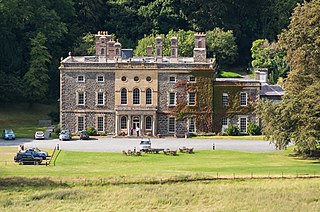
Nanteos is an 18th-century former country house in Llanbadarn-y-Creuddyn, near Aberystwyth, Ceredigion, Wales. A Grade I listed building, it is now a country house hotel. The gardens and parkland surrounding the mansion are listed on the Cadw/ICOMOS Register of Parks and Gardens of Special Historic Interest in Wales.

Cwmystwyth mines are located in Cwmystwyth, Ceredigion, Wales and exploited a part of the Central Wales Orefield.

Trawsgoed is a community and an estate in Ceredigion, Wales. The estate is 8 miles (13 km) southeast of Aberystwyth, and has been in the possession of the Vaughan family since 1200. The Vaughans are descended from Collwyn ap Tangno, founder of the fifth noble tribe of North Wales, Lord of Eifionydd, Ardudwy, and part of Llŷn, who had his residence on the site of Harlech Castle.

Thomas Johnes FRS was a Member of Parliament, landscape architect, farmer, printer, writer and social benefactor. He is best known for his development of the Hafod Estate in Wales.

Creuddyn was a medieval commote and, later, a lordship in Ceredigion, Wales. It was located between the rivers Ystwyth and Rheidol, and was one of the three commotes of Cantref Penweddig. The name, of Old Welsh origin, probably refers to the Pen Dinas hill fort, anciently known as Dinas Maelor. The natural centre of the commote was Llanfihangel y Creuddyn where five roads meet at the village. The name survives in the name of a rural community and church of the same name; however the modern community is much smaller than the medieval commote.
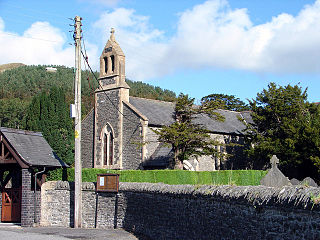
Saint Afan's Church (SN68387192) is located in Llanafan, 8 miles (13 km) east of Aberystwyth, Ceredigion, in Wales.

Llanfarian is a village, community and electoral ward in the county of Ceredigion, Mid-Wales, south of the administrative centre Aberystwyth.

The B4574 is a road linking the villages of Pont-rhyd-y-groes in Ceredigion, Wales, and Devil's Bridge, 12 miles (19 km) east of Aberystwyth, and noted for three bridges built one above each other as well as for its falls and narrow gauge steam railway. The route is six miles (9.7 km) long, and has been described by the AA as one of the ten most scenic drives in the world

The Dolaucothi Estate is situated about 1 mile (1.6 km) north-west of the village of Caio up the Cothi Valley in the community of Cynwyl Gaeo, in Carmarthenshire, Wales. Dolaucothi means ‘the meadows of the Cothi’.
Falcondale is a hamlet in the community of Lampeter, Ceredigion, Wales, and occupies a low bluff overlooking the Nant Creuddyn north-west of Lampeter.
The ninth election for Cardiganshire County Council took place in March 1913. They were preceded by the 1910 election and followed by the 1919 election as no election took place in 1916 due to the First World War.

The present church of St Bledrws, in the village of Betws Bledrws, near Lampeter, Ceredigion, Wales, is a 19th-century building. However, the same site is believed to have been previously used for other places of worship since much earlier times. The Coflein website states that the older church was in mediaeval times dedicated to St Michael, although the dedication had been changed to St Bledrws by 1833.






